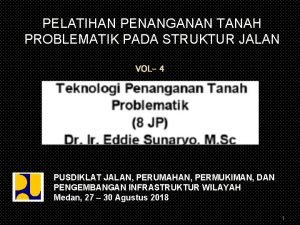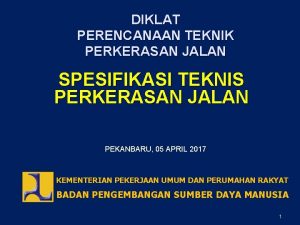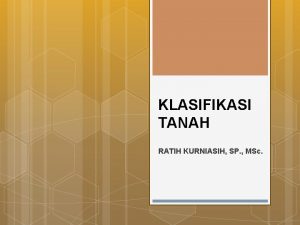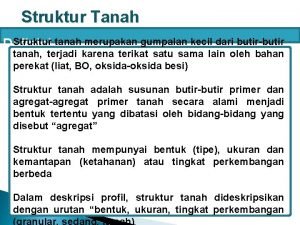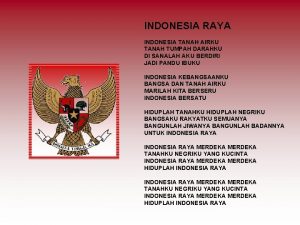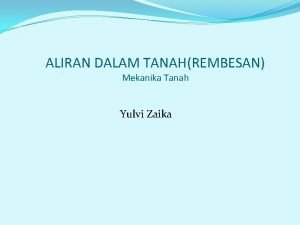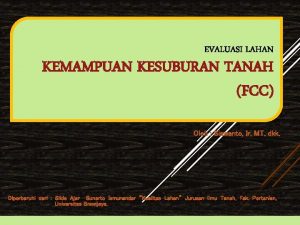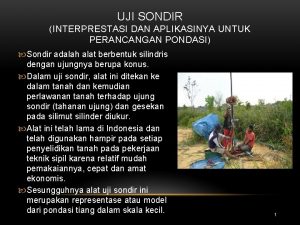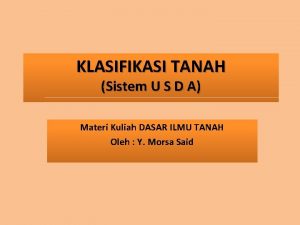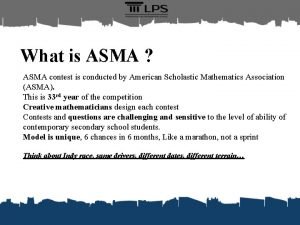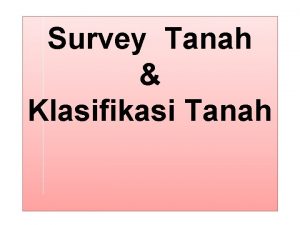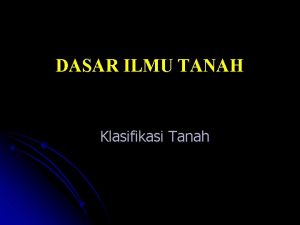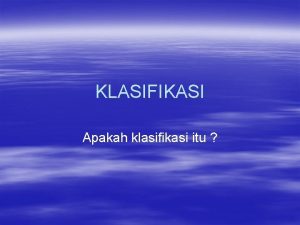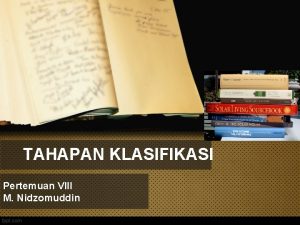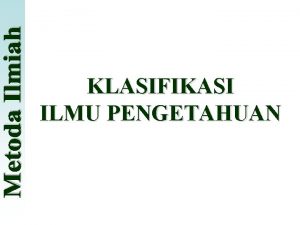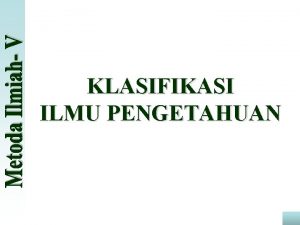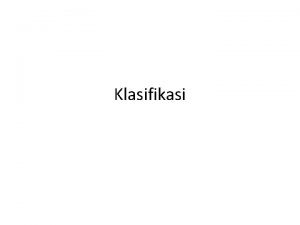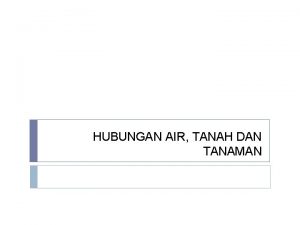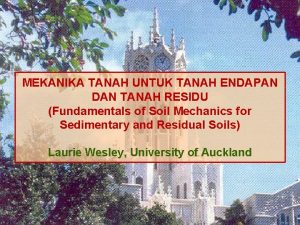KLASIFIKASI TANAH AASHTO AASHTO stands for American Association















- Slides: 15

KLASIFIKASI TANAH AASHTO

AASHTO stands for American Association of State Highway and Transportation Officials. AASHTO proposed soil classification in 1929 and had undergone several revisions till now. It is widely used to classify soil for construction of roads, highways, and airfield (runways, taxiways) especially for subgrade material. Pre-requisites of AASHTO soil classification system are: 1) 2) 3) Mechanical analysis Liquid limit Plasticity Index

Grain Size: 1) Gravel: Fraction passing 75 mm sieve and retained on #10 (2 mm) US sieve 2) Sand: Fraction passing #10 sieve and retained #200 sieve 3) Silt and Clay: Fraction passing #200 sieve

Plasticity: 1) Term silty is applied when fine fractions have a PI < 10 2) Term clayey is applied when fine fractions have PI > 11 Note: If cobbles and boulders (larger than 75 mm) are encountered, they are excluded from the portion of the soil sample on which classification is made. However, %age of such material is recorded.

KLASIFIKASI UMUM(AASHTO) 8 groups: A 1~ A 7 (dengan sub grup) dan tanah organik A 8 Percobaan yang dibutuhkan sieve analysis dan Atterberg limits. ◦ Group index dengan formula, empiris untuk mengevaluasi tanah dalam subgrup ◦ ◦ A 1 ~ A 3 A 4 ~ A 7 Granular Materials Silt-clay Materials 35% pass No. 200 sieve 36% pass No. 200 sieve LL and PI untuk memisahakan tanah kelempungan dan kelanauan (hanya A 2 ) LL dand PI untuk memisahkan lanau dan lempung ◦ Tujuan pengklasifikasi adalah untuk konstruksi jalan ◦ ( lapisan subgrade) 5

Group Index For Group A-2 -6 and A-2 -7 F 200: percentase lolos saringan. 200 6

Klasifikasi tanah berbutir kasar (kurang 35% lolos saringan 200)

Klasifikasi tanah berbutir halus (lebih 35% lolos saringan 200)

Group A-1. The typical material of this group is a well-graded mixture of stone fragments or gravels, coarse sand, fine sand, and a non-plastic or sligthly plastic soil binder. This group also includes stone fragments, gravels, coarse sand, volcanic cinders etc, without a well-graded binder of fine material. - Subgroup A-1 -a includes those materials consisting predominantly of stone fragments or gravel, either with or without a well-graded binder of fine material. - Subgroup A-1 -b includes those materials consisting predominantly of coarse sand with or without a well-graded soil binder. · Group A-3. The typical material of this group is fine beach sand or fine desert blown sand without silty or clayey fines or with a small amount of non-plastic silt. This group includes also stream-deposited mixtures of poorly graded fine sand

Group A-2. This group includes a wide variety of “granular” materials, which are at the borderline between the materials falling in groups A-1 and A-3 and the silty-clay materials of group A-4 through A-7. It include any materials not more than 35% of which passes a #200 sieve and which cannot be classified as A-1 or A-3 because of having fines content or plasticity, or both, in excess of the limitations for those groups. · Group A-4. The typical material of this group is a non-plastic or moderately plastic silty soil 75% or more of which usually passes the #200 sieve. The group also includes mixture of fine silty soil and up to 64% of sand gravel retained on the #200 sieve. · Group A-5. The typical material of this group is similar to that described under Group A-4, but it may be highly elastic, as indicated by high liquid limit.

Group A-6. The typical material of this group is a plastic clay soil 75% or more of which usually passes the #200 sieve. The group also includes mixtures of fine clayey soil and up to 64% of sand gravel retained on the #200 sieve. Materials of this group usually have high volume change between wet and dry states. · Group A-7. The typical material of this group is similar to that described under Group A-6, but it has the high liquid limits characteristics of the A-5 group and may be elastic as well as subject to high volume change.

Subgroup A-7 -5 includes those materials which have moderate plasticity indexes in relation to liquid limit and which may be highly elastic as well as subject to considerable volume change. ·Subgroup A-7 -6 includes those materials which have high plasticity indexes in relation to liquid limit and which are subject to extremely high volume change. · Group A-8. The typical material of this group is peat and muck soil ordinarily found in obviously unstable, swampy areas. Characterized by: · low density · high compressibility · high water content and · high organic matter content.



Tentukan Klasifikasi Tanah A dan B
 Tabel klasifikasi tanah aashto
Tabel klasifikasi tanah aashto Ukuran ayakan pasir
Ukuran ayakan pasir Pentingnya klasifikasi tanah
Pentingnya klasifikasi tanah Gumpalan tanah
Gumpalan tanah Indonesia tanah airku tanah tumpah darah
Indonesia tanah airku tanah tumpah darah Yulvi zaika
Yulvi zaika Diagram plastisitas casagrande
Diagram plastisitas casagrande Fertility capability classification
Fertility capability classification Klasifikasi tanah berdasarkan data sondir
Klasifikasi tanah berdasarkan data sondir Klasifikasi tanah menurut usda
Klasifikasi tanah menurut usda Klasifikasi tanah uscs
Klasifikasi tanah uscs Asma math
Asma math Colbert, stephen. home page. 1 nov. 2006.
Colbert, stephen. home page. 1 nov. 2006. Galvanize it
Galvanize it Brand asset valuator
Brand asset valuator The american heart association recommends child cpr for
The american heart association recommends child cpr for
